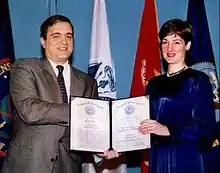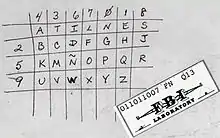Ana Montes
Ana Belén Montes[1] (born February 28, 1957) is a former American senior analyst at the Defense Intelligence Agency in the United States who spied on behalf of the Cuban government for 17 years.[2]
Ana Montes | |
|---|---|
 | |
| Born | Ana Belén Montes February 28, 1957 |
| Nationality | American |
| Alma mater | University of Virginia Johns Hopkins University |
| Occupation(s) | Intelligence analyst Spy (for Cuba) |
| Criminal status | Released |
| Conviction(s) | Conspiracy to commit espionage (18 U.S.C. § 794) |
| Criminal penalty | 25 years imprisonment |
| Imprisoned at | FMC Carswell |
On September 21, 2001, Montes was arrested and subsequently charged with conspiracy to commit espionage for the government of Cuba. Montes pleaded guilty to spying and in October 2002, was sentenced to a 25-year prison term followed by five years' probation.[3][4] She was released on January 6, 2023, after serving 20 years.[5]
Early life and career
Montes was born in Nuremberg, in what was then West Germany, where her father, Alberto Montes, was posted as a United States Army doctor.[4] Her family originated from the Asturian region in Spain, and her grandparents had immigrated to Puerto Rico.[1] The family later lived in Topeka, Kansas, and then Towson, Maryland, where she graduated from Loch Raven High School in 1975. In 1979 she earned a degree in foreign affairs from the University of Virginia, and in 1988 she finished a master's degree at Johns Hopkins University School of Advanced International Studies.[4]
Montes' brother and sister, Tito and Lucy, became Federal Bureau of Investigation employees.[4] Tito was an FBI special agent,[4] and Lucy was a longtime FBI language analyst and translator.[4][2] Ana Montes' former boyfriend, Roger Corneretto, was an intelligence officer specializing in Cuba for the Pentagon.[4]

Montes joined the Defense Intelligence Agency (DIA) in September 1985 after working for the United States Department of Justice. Her first assignment was at Bolling Air Force Base in Washington where she worked as an intelligence research specialist. In 1992, Montes was selected for the DIA's Exceptional Analyst Program and later traveled to Cuba to study the Cuban military.[4]
Prior to her arrest, she lived in a two bedroom co-op apartment in the Cleveland Park neighborhood of Washington, D.C.[4]
Montes advanced rapidly through the ranks at the DIA and became its most senior Cuban analyst.[6] Her co-workers regarded her as responsible and dependable, and noted her "no-nonsense" attitude. Prosecutors would later allege that Montes was already working for the Cubans when she joined the DIA in 1985.[4]
Espionage
Montes had been recruited by Cuban intelligence while she was a university student at Johns Hopkins University in the 1980s. She became known to other students for her strong opinions in support of left-wing Latin American movements like the Sandinista National Liberation Front in Nicaragua. A Cuban agent eventually approached her. After recruiting her, the Cuban Intelligence Service groomed her to pursue employment with the Defense Intelligence Agency.[7][4]
In their charging documents, federal prosecutors stated:[4]
Montes communicated with the Cuban Intelligence Service through encrypted messages and received her instructions through shortwave encrypted transmissions from Cuba. In addition, Montes communicated by coded numeric pager messages with the Cuban Intelligence Service by public telephones located in the District of Columbia and Maryland. The codes included 'I received message' or 'danger.'
The prosecutors further stated that all of the information was on water-soluble paper that could be rapidly destroyed.
During the course of the investigation against her, it was determined that Montes had passed a considerable amount of classified information to the Cuban Intelligence Directorate, including the identities of four US spies in Cuba. In 2007, American DIA counterintelligence official Scott W. Carmichael publicly alleged that it was Ana Montes who told Cuban intelligence officers about a clandestine US Army camp in El Salvador.[7][8] Carmichael alleged that Montes knew about the existence of the Special Forces camp because she visited it only a few weeks before the camp was attacked in 1987 by Cuban-supported guerrillas of the Farabundo Martí National Liberation Front (FMLN).[8]
Carmichael, who had led the DIA investigation of Montes, named her as being directly responsible for the death of Green Beret Sergeant Gregory A. Fronius who was killed at El Paraíso, El Salvador, on March 31, 1987, during the FMLN attack.[8] Carmichael characterized the damage Montes caused to the DIA and other US intelligence agencies as "exceptionally grave," and stated that she compromised a "special access program" that was kept even from him, the lead investigator on her case.[7]

Carmichael further alleged that, unlike many in the US intelligence community, he believed that Montes' penetration of the DIA was not the exception, but the rule, and that the Cuban intelligence services had multiple spies and moles within US intelligence agencies.[8]
In 2004 a federal indictment alleged that Montes had assistance from another Cuban agent, Marta Rita Velázquez, once a legal officer at the United States Agency for International Development, who was further alleged to have recruited Montes into espionage. The federal indictment was unsealed in April 2013. Velázquez has been outside the US since 2002, apparently in Sweden, which does not have an extradition treaty with the US for spy cases.[9]
Arrest
Montes was arrested by the Federal Bureau of Investigation at her office on September 21, 2001. Prosecutors stated that Montes had been privy to classified information about the US military's impending invasion of Afghanistan in October 2001, and that they did not want her revealing this information to potential enemies.[4]
In 2002, Montes pleaded guilty to the charge which could have carried the death penalty, but was sentenced to 25 years in prison in October of the same year after accepting a plea agreement with the U.S. government.[4] At the sentencing hearing, Montes described U.S. policy towards Cuba as cruel and unfair and said "I felt morally obligated to help the island defend itself from our efforts to impose our values and our political system on it".[10][11] After pleading guilty, Montes told CIA debriefers that she desired to protect Cuba from the U.S. and that she believed that "all the world is one country."[2] In a 2013 letter from prison to a friend, Montes wrote that "I believe that the morality of espionage is relative. The activity always betrays someone, and some observers will think that it is justified and others not, in every case."[2]
Incarceration

Montes was incarcerated at FMC Carswell in Fort Worth, Texas.[4] FMC Carswell is listed by the Federal Bureau of Prisons as a facility located in the northeast corner of the Naval Air Station, Joint Reserve Base, Fort Worth, which provides specialized medical and mental health services to female offenders.
Montes is listed as FMC Register #25037-016. She was released on January 6, 2023.[12] Having been released, she will be monitored, including her internet usage, for five years. Montes will not be allowed to contact "foreign agents" or work for the US government "without permission".[13]
She is currently living in Puerto Rico and continues to speak out against the US sanctions against Cuba.[14]
See also
Further reading
- Popkin, Jim (January 3, 2023). Code Name Blue Wren: The True Story of America's Most Dangerous Female Spy—and the Sister She Betrayed. Harlequin. ISBN 978-0-3697-3423-5.[15]
- Carmichael, Scott (October 1, 2009). True Believer: Inside the Investigation and Capture of Ana Montes, Cuba's Master Spy. Naval Institute Press. ISBN 978-1-61251-253-2.
- "FBI 100 The Case of the Cuban Spy". Federal Bureau of Investigation.
- Marquis, Christopher (October 20, 2001). "U.S. Restricts Cuban Diplomats in Capital After Spy Charges". The New York Times. Retrieved January 27, 2014.
- Undersecretary of State John Bolton, CBS News interview, May 11, 2002
- Manuel, Cereijo. "Ana Belen Montes: The chronicle of an American Spy for the Cuban Government". LatinAmericanStudies.org.
- "Statement by Ana Belen Montes, who received 25-year sentence for spying for Cuba". Miami Herald. October 16, 2002 – via LatinAmericanStudies.org.
References
- Iglesias, María José (April 28, 2013). "Ana Montes, la asturiana que espió para Fidel". La Nueva España (in Spanish). Retrieved August 7, 2016.
- Popkin, Jim (December 22, 2014). "Two double agents, a prison swap and the code from outer space: did this spy-v-spy duel save US-Cuban relations". The Guardian.
- "An Unrepentant Montes Sentenced to 25 Years". cicentre.com. The Centre for Counterintelligence and Security Studies. October 16, 2002. Archived from the original on August 7, 2007.
- Popkin, Jim (April 18, 2013). "Ana Montes did much harm spying for Cuba. Chances are, you haven't heard of her". Washington Post Magazine. Retrieved August 7, 2016.
- "Cuba spy Ana Belen Montes released after 20 years behind bars". Reuters. January 7, 2023. Retrieved January 7, 2023.
- "Ana Montes: Cuban Spy". Federal Bureau of Investigation. Retrieved January 24, 2018.
- Carmichael, Scott (March 3, 2007). True Believer: Inside the Investigation and Capture of Ana Montes, Cuba's Master Spy. Annapolis, Maryland: Naval Institute Press. ISBN 978-1-59-114100-6.
- Gertz, Bill (March 14, 2007). "DIA official warns about Cuban spies". The Washington Times. Retrieved August 7, 2016.
- "Charge in Cuban spy case unsealed, accusing ex-State Dept. officer of conspiracy". The Washington Post. Associated Press. April 25, 2013. Archived from the original on April 26, 2013.
- "Cuba spy Ana Belen Montes released after 20 years behind bars". Reuters. January 7, 2023. Retrieved September 10, 2023.
- Latell, Brian (August 2, 2014). "New revelations about Cuban spy Ana Montes". Miami Herald. Archived from the original on April 19, 2015. Retrieved August 7, 2016.
- "Federal Bureau of Prisons Inmate Locator". Federal Bureau of Prisons. United States Department of Justice. Retrieved April 18, 2020.
BOP Register Number: 25037-016
- Murphy, Matt (January 8, 2023). "Ana Montes: Top spy freed in US after more than 20 years". BBC. Retrieved January 8, 2023.
- Bailey, Chelsea "Ana Montes: How Cuban spy used incredible memory to betray US" BBC News (Jan. 11, 2023) (accessed Jan. 11, 2023)
- "Transcript: Jim Popkin, Author "Code Name Blue Wren"". Washington Post. Retrieved January 15, 2023.